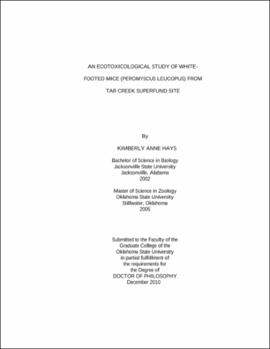| dc.contributor.advisor | McBee, Karen | |
| dc.contributor.author | Hays, Kimberly Anne | |
| dc.date.accessioned | 2013-11-26T08:28:23Z | |
| dc.date.available | 2013-11-26T08:28:23Z | |
| dc.date.issued | 2010-12 | |
| dc.identifier.uri | https://hdl.handle.net/11244/7034 | |
| dc.description.abstract | Scope and Method of Study: The purpose of this study was to assess the effects of heavy metals on white-footed mice from Tar Creek Superfund Site. Animals used in the study were collected from Tar Creek Superfund Site, and two reference sites, Osage Wildlife Management Area and Sequoyah National Wildlife Refuge. Tissues from additional sites were obtained from the Oklahoma State University Collection of Vertebrates Frozen Tissue Collection. Assessment included measurement of anogenital distance, metaphase chromosome analysis, and amplified fragment length polymorphism analysis. | |
| dc.description.abstract | Findings and Conclusions: There was no significant decrease in anogenital distance in individuals from TCSFS. There was significant sexual dimorphism and positive correlation between mass and AGD at all three sites. Metaphase chromosome analysis revealed no significant difference in the incidence of structural chromosomal aberrations between TCSFS and two matched reference sites. Chromatid breaks and acentric fragments were the most commonly observed type of aberration at all sites. There was no significant difference in mitotic index among sites. Amplified fragment length polymorphism revealed a significant difference in population genetic structure between metal-exposed populations and geographically similar reference populations in Oklahoma; however, only one of the metal-exposed populations differed from all reference populations. Principal coordinates analysis did reveal strong geographic clustering of the populations with the three most western populations clustering and the five most eastern populations clustering together. The population genetic structure measured in AFLP analysis is similar to distribution of two karyotypic races of white-footed mice. The two races differ by three pericentric inversions and group into northeastern and southwestern groups with a hybrid zone in central Oklahoma. The eastern cluster from this study corresponds to the distribution of the northeastern cytotype and the western cluster corresponds to the southwestern cytotype. | |
| dc.format | application/pdf | |
| dc.language | en_US | |
| dc.rights | Copyright is held by the author who has granted the Oklahoma State University Library the non-exclusive right to share this material in its institutional repository. Contact Digital Library Services at lib-dls@okstate.edu or 405-744-9161 for the permission policy on the use, reproduction or distribution of this material. | |
| dc.title | Ecotoxicological study of white-footed mice (Peromyscus leucopus) from Tar Creek Superfund Site | |
| dc.contributor.committeeMember | Fox, Stanley F. | |
| dc.contributor.committeeMember | Lovern, Matthew B. | |
| dc.contributor.committeeMember | Pope, Carey N. | |
| osu.filename | Hays_okstate_0664D_11212 | |
| osu.accesstype | Open Access | |
| dc.type.genre | Dissertation | |
| dc.type.material | Text | |
| dc.subject.keywords | amplified fragment length polymorphism | |
| dc.subject.keywords | anogenital distance | |
| dc.subject.keywords | peromyscus leucopus | |
| dc.subject.keywords | metaphase chromosome analysis | |
| thesis.degree.discipline | Zoology | |
| thesis.degree.grantor | Oklahoma State University | |
